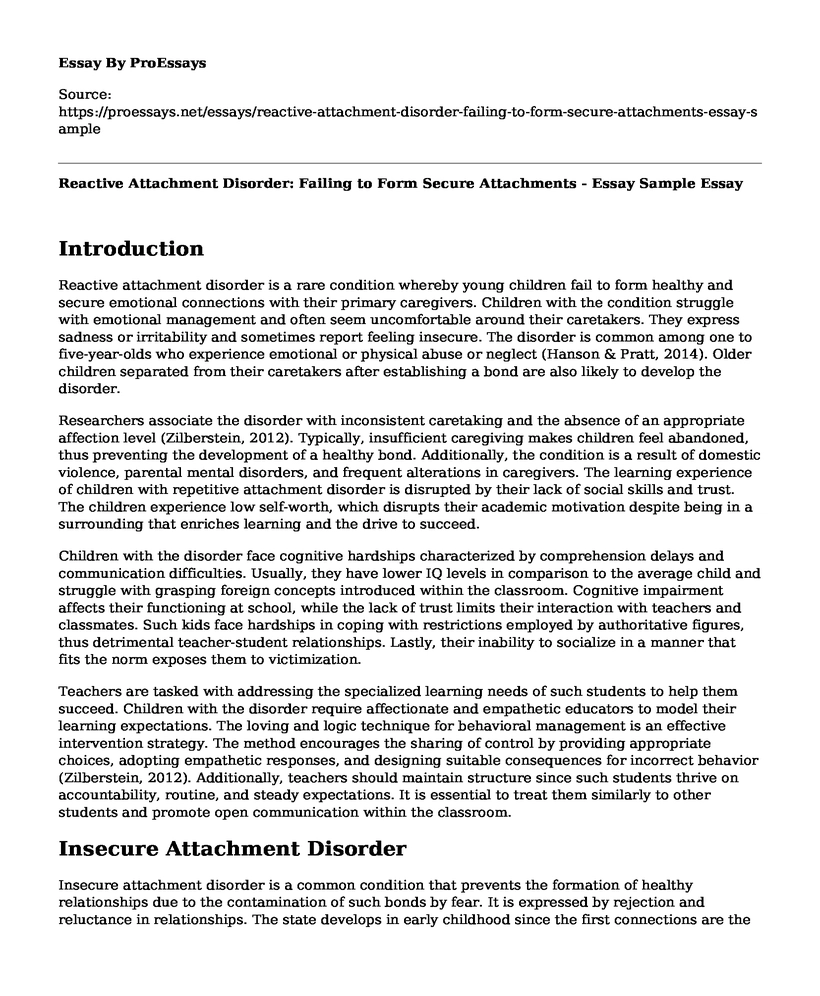Introduction
Reactive attachment disorder is a rare condition whereby young children fail to form healthy and secure emotional connections with their primary caregivers. Children with the condition struggle with emotional management and often seem uncomfortable around their caretakers. They express sadness or irritability and sometimes report feeling insecure. The disorder is common among one to five-year-olds who experience emotional or physical abuse or neglect (Hanson & Pratt, 2014). Older children separated from their caretakers after establishing a bond are also likely to develop the disorder.
Researchers associate the disorder with inconsistent caretaking and the absence of an appropriate affection level (Zilberstein, 2012). Typically, insufficient caregiving makes children feel abandoned, thus preventing the development of a healthy bond. Additionally, the condition is a result of domestic violence, parental mental disorders, and frequent alterations in caregivers. The learning experience of children with repetitive attachment disorder is disrupted by their lack of social skills and trust. The children experience low self-worth, which disrupts their academic motivation despite being in a surrounding that enriches learning and the drive to succeed.
Children with the disorder face cognitive hardships characterized by comprehension delays and communication difficulties. Usually, they have lower IQ levels in comparison to the average child and struggle with grasping foreign concepts introduced within the classroom. Cognitive impairment affects their functioning at school, while the lack of trust limits their interaction with teachers and classmates. Such kids face hardships in coping with restrictions employed by authoritative figures, thus detrimental teacher-student relationships. Lastly, their inability to socialize in a manner that fits the norm exposes them to victimization.
Teachers are tasked with addressing the specialized learning needs of such students to help them succeed. Children with the disorder require affectionate and empathetic educators to model their learning expectations. The loving and logic technique for behavioral management is an effective intervention strategy. The method encourages the sharing of control by providing appropriate choices, adopting empathetic responses, and designing suitable consequences for incorrect behavior (Zilberstein, 2012). Additionally, teachers should maintain structure since such students thrive on accountability, routine, and steady expectations. It is essential to treat them similarly to other students and promote open communication within the classroom.
Insecure Attachment Disorder
Insecure attachment disorder is a common condition that prevents the formation of healthy relationships due to the contamination of such bonds by fear. It is expressed by rejection and reluctance in relationships. The state develops in early childhood since the first connections are the foundation of future relationships (Crawford, 2017). Children with insecure attachment expect abandonment and harm from people, hence avoid healthy relationships. The disorder is categorized into three forms; disorganized, avoidant, and ambivalent attachment. Typically, disorganized attachment is witnessed in individuals who suffered from childhood abuse. Lack of affection and support during stressful situations and immense physical punishment causes the reaction.
Contradictory childhood relationships cause ambivalent attachment. Children raised by inconsistent caregivers become over-sensitive, dependent, and always seek approval. Relationships often become a source of anxiety hence cope by avoiding them altogether. Avoidant attachment involves difficulty in developing close relations. It results from childhood neglect, emotional or physical abuse, which causes distrust (Zilberstein, 2012). Insecurely attached individuals experience learning difficulties due to the emotional turmoil and struggle to identify with others. Insecure learners are less enthusiastic, persistent, and self-confident. Additionally, they struggle with reading comprehension and have lower verbal capacities. Usually, such students lack curiosity and academic interest hence lower performance compared to securely attached learners.
Students can promote the success of insecurely attached students by creating a dynamic and interpersonal environment whereby the pupils feel comfortable enough to seek support when troubled. Such environments foster curiosity and favor the uncertainty created by not knowing a specific theoretical concept. Teachers also need to encourage independence in task execution without activating the constant need for help. When students believe in their ability to handle challenges, their learning interest awakens. Lastly, it is advisable to establish a caring and understanding relationship.
References
Crawford, T. N. (2017). Insecure attachment disorder. European Journal of Personality, 21(2), 191-208.
Hanson, R. F., & Spratt, E. G. (2014). Reactive attachment disorder: What we know about the disorder and implications for treatment. Child Maltreatment, 5(2), 137-145.
Zilberstein, K. (2012). Clarifying core characteristics of attachment disorders: A review of current research and theory. American journal of orthopsychiatry, 76(1), 55-64.
Cite this page
Reactive Attachment Disorder: Failing to Form Secure Attachments - Essay Sample. (2023, Mar 14). Retrieved from https://proessays.net/essays/reactive-attachment-disorder-failing-to-form-secure-attachments-essay-sample
If you are the original author of this essay and no longer wish to have it published on the ProEssays website, please click below to request its removal:
- Hume Moral Judgments and Self-Love Theories Essay
- My Three Characteristics Essay
- Military Social Work Essay Example
- I Am What I Say: How One Book Changed the Way I See the World
- Counselling Adults With Learning Disabilities Case Study Paper Example
- Personality: Nature vs Nurture: The Debate Over Development - Research Paper
- Stress and Resilience in the Work Place - Essay Sample







